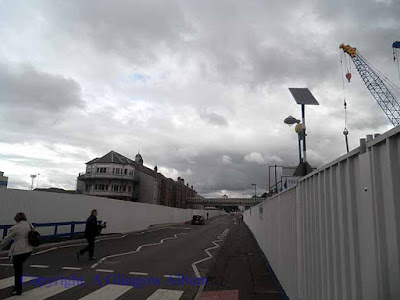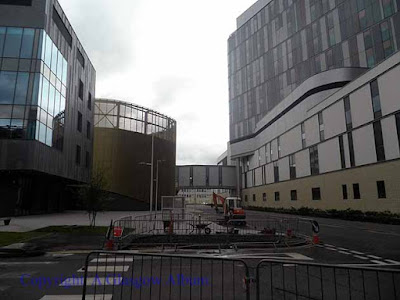- John Aubrey
'Oh roads we used to tread,
Fra' Maryhill to Pollokshaws - fra' Govan to Parkhead!
- Kipling, 'McAndrew's Hymn'
'Photography can be a mirror and reflect life as it is, but I also think that perhaps it is possible to walk like Alice, through a looking-glass, observe the puzzles in one’s head and find another kind of world with the camera.' - Tony Ray-Jones
Welcome to my wee photoblog on Glasgow, where we feature the joys and unjoys of walking and cycling through a fascinating, beautiful and often badly run city. For the blog's origin and a list of all posts see the 'Introduction' post -
http://glasgowalbum.blogspot.com/2010/02/introduction.html
Feel free to drop me an email with suggestions, offers of £20 notes etc. The address is damnyouebay@gmail.com. I have had to start watermarking the pics as I have come across one big website using a pic without permission - I suppose there must be others.
If you are a private individual and want to use any of the pics for non-commercial purposes please get in touch and I will usually be happy to say 'Aye' for free - just give the Album a credit. If you want to use a pic for commercial purposes a small mutually agreed fee and a credit will suffice. And you can follow me on Twitter if you wish: Edwin Moore@GlasgowAlbum.
Today is Monday, 24 August 2015, and we are off to the Queen Elizabeth University Hospital in Govan for an experiment in the Neurology Dept. See
From the above link -
'Glasgow's new hospital has been renamed the Queen Elizabeth University Hospital after the monarch officially opened it.
The £842m facility, formerly known as the South Glasgow University Hospital, started taking patients in April.
The Queen and the Duke of Edinburgh visited the hospital and the next-door Royal Hospital for Sick Children during a day in Glasgow.
The 1,109-bed facility was built on the site of Southern General is one of the largest acute hospitals in the UK.
The new campus, which has been dubbed a "super-hospital", replaces the Royal Hospital for Sick Kids at Yorkhill, the Southern General Hospital, the Western and Victoria infirmaries and the Mansionhouse Unit.'
 |
| Ah, a Clyde. They pop up everywhere. See https://en.wikipedia.org/wiki/Clyde_%28mascot%29 |
 |
| We are outside the Royal Hospital for Sick Children part of the Death Star |
 |
| Like many Glaswegians, we were born in the old Southern General maternity. A cold coming we had of it in 1947. |
 |
| The naming of the hospital is proving controversial with some. See http://www.eveningtimes.co.uk/news/13840677.Protest_planned_over_Glasgow_s_new_hospital_name/ |
 |
| Of more concern to most Glaswegians are the waiting times. See http://www.bbc.co.uk/news/uk-scotland-glasgow-west-34560615 |
 |
| Older bit of hospital down there |
 |
| We are heading for Neurology |
 |
| We are Here |
 |
| When we are fiinished in Neurology we will be going into the Star across that bridge |
 |
| Neurology in here. I have complex instructions for getting to the top |
 |
| The Death Star looms |
 |
| Looking down |
 |
| We are finished - at the end of the blood test we are placed in the control group so there will be no further calls on our time |
 |
| On the bridge |
 |
| The other side |
 |
| The Way to the Sanctuary is also the Way Out |
 |
| How high they build hospitals! Lighted cliffs, against dawns Of days people will die on. ‘How’, Larkin |
 |
| On the bus out |
Thank you for browsing, dear visitor.
My other barking wee blog is
http://parkeddogs.blogspot.com/
(Cartoon by Katherine Grainger created for the St Wilfrid's Hospice annual Charity Auction 2014. No connection with my Scotland book - I just like it)
Reviews of Scotland: 1000 Things You Need to Know
RADIO AND TELEVISION
'I love it - I'm giving this copy to a friend and buying another for myself' - Darren Adam, Presenter, Radio Forth, 17 November 2008
‘It’s a great wee book’ – Stephen Jardine, introducing Edwin Moore on Scottish Television’s Five-Thirty Show
'A fantastic book' - Scott Wilson , talk 107 Breakfast Show host
'A great read' - Dougie Jackson, Drivetime host, Smooth Radio 105.2
THE PRESS
'Despite its apparently humorous format, this is a serious and extensive dictionary on all things Scottish; from Jean Redpath to Lorne sausage, from Flodden to the Corries. Is particularly good on history and minutiae. There's a useful chapter on famous Scottish legal cases and another on literature. Excellent' - Royal Scottish Legion, Feb 2009
'This is the ultimate Scottish reference book' - Waterstones Christmas catalogue, 2008
'This is a fascinating look at the history of Scotland: its languages, politics and great achievements, from its origins in the ancient landmass of Laurentia 400 million years ago, to devolution and Billy Connolly. Edwin Moore has collected a thousand important facts about this beautiful country, covering Scottish history and culture, correcting misconceptions, and examining the mysteries of haggis and bagpipes with insight, warmth and impressive attention to detail' - The Good Book Guide, November 2008
'This is a recipe for revealing how horribly ill informed you are about your country. Although, if you are skillful, you can nod sagely as you read some new fact and mutter 'Ah, yes!' as if recalling the information from your excellent schooling. Where else will you find a real recipe for making haggis from scratch side by side with a potted biography of David Hume; a section of the Declaration of Arbroath and the curiously touching fact that Lulu was only 15 when she had a hit with 'Shout'? The whole thing is of course, silly - but oh so addictive.' - Matthew Perren, i-on Glasgow, December 2008
'. . . well crafted and witty' - Bill Howatson, Aberdeen Press and Journal, 18 October 2008
‘While most of Edwin’s entries are entertaining and scholarly – he writes like a Scottish Bill Bryson – it is when he takes an interest in the backwaters of history, the details lost down the back of the sofa, that he is at his best’ – Jack McKeown, The Courier, 27 October 2008
'History, it is said, is written by the victors. Trivia, meanwhile, is written by the guys with the smeared spectacles and the breathable rainwear. The first discipline is linear and causal; to quote from Alan Bennett’s play The History Boys, history is “just one f****** thing after another”. Things look different, though, when viewed through the prism of trivia. The past is reduced to one big coleslaw of fascinating facts that in their randomness tell a more mixed-up tale entirely.
The first approach leads to big, frowning books by the likes of Tom Devine and Michael Fry. The latter results in small, cheerful books such as Scotland: 1,000 Things You Need to Know, Edwin Moore’s valiant attempt to navigate the more trivial contours of enlightenment and clearances, crown and parliament, dirt and deity.
Moore proceeds from a sincere and controversial first principle: Scotland is really a rather pleasant and interesting place. . .As a work of popular scholarship, though, it’s in a different league to the Scottish novelty titles that get stocked next to the bookstore tills as potential impulse purchases, those little handbooks of parliamo Caledonia and regional braggadocio, such as Weegies vs Edinbuggers.' - Allan Brown The Sunday Times, 21 September 2008
'In his book, Scotland: 1000 Things You Need to Know, Edwin celebrates all that sets us Scots as a race apart - our language, law, flora, food, and of course, our people. From our poets, architects and inventors, to our artists, entertainers and fighters. But he doesn't shy away from the more unpleasant aspects of our history. . .' - Robert Wight, Sunday Post, 14 September 2008
‘We think we know all about William Wallace, Robert the Bruce and the Union of the Crowms. However, according to Edwin Moore, author of , Scotland: 1000 Things You Need to Know, we’re still in the dark about many aspects of our history and culture. . . The Big Issue looks at 20 of the most astonishing examples of secret Scotland.’ – The Big Issue, 18-24 September 2008
'What's the connection between Homer Simpson and Larbert, and why are generations of lawyers grateful to a Paisley snail? Need to know more? Author Edwin Moore has gathered 1000 facts like these about Scotland in a quirky new book. Brian Swanson selects a few favourites. . .' - Scottish Daily Express, 13 September 2008
'The palm for Christmas-stocking books seems to have passed recently to popular science, with best selling titles every year such as Why Don’t Penguins’ Feet Freeze? This year there has been a gallant attempt at a historical fight back. Scotland: 1,000 Things You Need to Know(Atlantic Books, £12.99) asks (and answers) such post-turkey questions as ‘How many kings of Scotland died in their beds?’, ‘Who on earth decided that the Declaration of Arbroath was the cornerstone of modern democracy?’ or ‘Why is iron brew spelled Irn-Bru?’ Mark Mazower,History Today; The Best of History in 2008, December 2008
'A real treat for the serendipitous Scotophile' - Reginald Hill
FROM THE INTERWEB
www.Booksfromscotland.com (on the new paperback edition)
Book of the Month, May 2010
'Whether it's Scottish lochs or Enlightenment philosophers, the facts of the devolution referendums or the mysteries of Irn-Bru, myths will be debunked and truths revealed in this light-hearted but rigorous overview of Scottish history and culture.'
Also available for download on Amazon's e-book store is my 100 Brief Encounters
http://www.amazon.co.uk/100-Brief-Encounters-ebook/dp/B006CQ8G84/ref=sr_1_1?s=books&ie=UTF8&qid=1322393003&sr=1-1
Here are some reviews of the print edition (published by Chambers in 2007) -
Edwin Moore's quirky collection of a hundred encounters between (mostly) important historical figures is a gem of a book. Where else could you get concise enlightening accounts of Henry VIII wrestling with Francis I, Geronimo surrendering to General Miles, Ernest Hemingway presenting Fidle Castro with a fishing trophy or (as seen on the books cover) a baby faced Bill Clinton shaking hands with John F Kennedy. A marvelous 'little window on human history. ' - Dominic Kennerk, Waterstone's Product Planning and Promotions Co-ordinator (From the Waterstone's 'We Recommend' list for 2008)
Witty, light and packed with information -- The Sunday Herald
In 1936, in the wake of winning a clutch of gold medals at the Berlin Olympics, the great athlete Jesse Owens was snubbed by an imperious leader, on racial grounds. Popular belief would have it that the leader was Hitler, who is said to have stormed off, furious to see a black man beating European athletes. In fact the man in question was President Roosevelt, who worried that paying attention to Owens' triumphs might be a vote loser. Although Owens and the German Chancellor never talked, Owens claimed that Hitler greeted him with an enthusiastic wave. Such near-misses, shakings of hands and ships-in-the-night meetings are the subject of Brief Encounters – Meetings between mostly remarkable people, a likeable new book by Edwin Moore (Chambers £7.99). Flicking through the index, you will find some expected encounters (Dante stares at Beatrice, Corday stabs Marat, The Beatles strum along to a Charlie Rich record round at Elvis's house), and the book's intriguing and memorable cover shows a baby-faced Bill Clinton manfully gripping the hand of JFK. But Moore has navigated past some of the more obvious collisions, collusions and confrontations of history (there is no Dr Livingstone, I presume) and much of the book's pleasure derives from lesser known incidents.
Inevitably, some of the accounts of earlier meetings are somewhat sketchy but Moore offers some piquant speculation, laced with humour (the book is tagged Reference / Humour, rather than History and this feels right, but the book, though wry and opinionated, never stoops to wackiness). I was intrigued to discover that, though Attila the Hun did die on his wedding night, it was not in drunken and lecherous debauchery, as his enemies maintained, but supposedly because he was generally a simple and clean-living man who had a few too many which brought on a particularly bad nosebleed.
Moore's book is full of such tales – it would be wrong of me to steal the tastiest morsels of his research and pepper this article with them, but look out for a subsidiary reason for the Gunpowder Plot (too many dour and powerful Scots in Parliament); a great meeting of great beards, as Castro wins the Hemingway prize for sea-fishing; Dali bringing a skeptical Freud round to the art of the surrealists; Buffalo Bill's wife claiming an aged Queen Victoria had propositioned him; Oscar Wilde getting a kiss from Walt Whitman, while Walter Scott was more taken with Burns's charismatic eyes. This is an enjoyable and vigorous rattle through some fascinating and believable yarns. My only quibble is that it's a little on the short side – let's have Volume 2 please Chambers! - Roddy Lumsden, www.Books from Scotland.com























































No comments:
Post a Comment